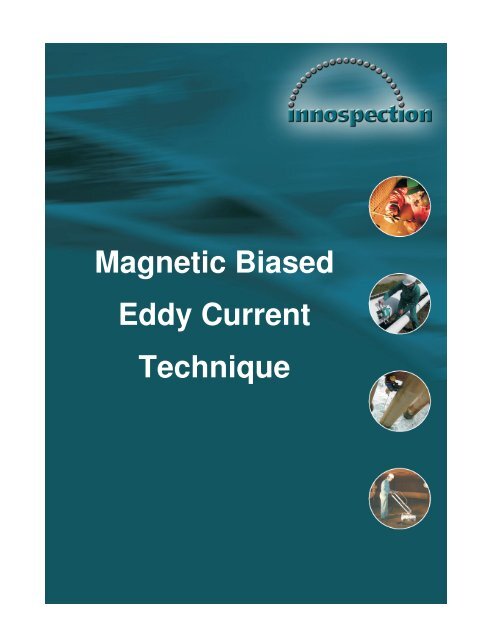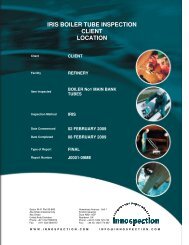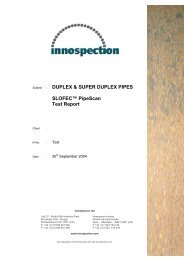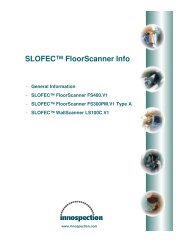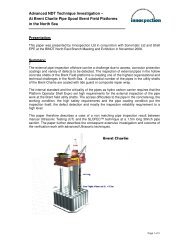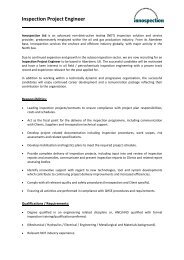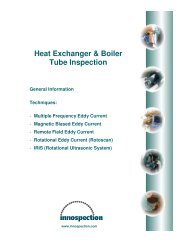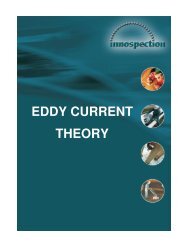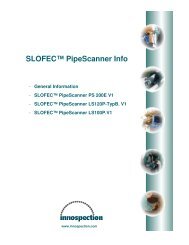Magnetic Biased Eddy Current - Innospection
Magnetic Biased Eddy Current - Innospection
Magnetic Biased Eddy Current - Innospection
Create successful ePaper yourself
Turn your PDF publications into a flip-book with our unique Google optimized e-Paper software.
<strong>Magnetic</strong> <strong>Biased</strong><br />
<strong>Eddy</strong> <strong>Current</strong><br />
Technique
<strong>Magnetic</strong> <strong>Biased</strong> <strong>Eddy</strong> <strong>Current</strong> Technique<br />
<strong>Magnetic</strong> <strong>Biased</strong> <strong>Eddy</strong> <strong>Current</strong> technique is one of the non destruction inspection techniques<br />
for heat exchanger and boiler tubes of ferromagnetic material.<br />
The <strong>Magnetic</strong> <strong>Biased</strong> <strong>Eddy</strong> <strong>Current</strong> technique is a combination of applied Direct <strong>Current</strong><br />
(DC) field lines and <strong>Eddy</strong> <strong>Current</strong> field lines. Both coil systems are combined in a single<br />
probe.<br />
The electromagnetic coil for DC field induction is adjustable for the magnetic field strength<br />
suitable to the material and wall thickness. The <strong>Eddy</strong> <strong>Current</strong> coils based between the<br />
electromagnetic systems can be applied with the <strong>Eddy</strong> <strong>Current</strong> frequency required for the<br />
inspection.<br />
The basis of the technique is the principle that in the case of defect, the magnetic field lines<br />
are running higher compressed in the remaining tube wall, which causes a permeability<br />
change in the tube wall and consequently changes the induced <strong>Eddy</strong> <strong>Current</strong> field in the<br />
tube wall. This is shown in Diagram 1.<br />
The <strong>Eddy</strong> <strong>Current</strong> signal then displays the defect severity in amplitude. The difference in the<br />
<strong>Eddy</strong> <strong>Current</strong> field line changes as well as the chance changing the DC field lines shows the<br />
differentiation between external to internal defects.<br />
Diagram 1:<br />
Principle of the <strong>Magnetic</strong> <strong>Biased</strong> <strong>Eddy</strong> <strong>Current</strong> Technique<br />
Page 2 of 3
<strong>Magnetic</strong> <strong>Biased</strong> <strong>Eddy</strong> <strong>Current</strong> Technique<br />
This technique is a fast technique as relatively high frequencies can be used. The possibility<br />
to analyse signal phase and signal amplitude makes it capable to differentiate defects from<br />
other occurrences.<br />
The signal amplitude is also able to detect and analyse the defect volume. Diagram 2 shows<br />
the signal analysis of the <strong>Magnetic</strong> <strong>Biased</strong> <strong>Eddy</strong> <strong>Current</strong> Technique.<br />
As the technique is not a direct <strong>Eddy</strong> <strong>Current</strong> based technique, the use of the absolute mode<br />
is limited. With the use of only the differential channel, it is very sensitive in the detection of<br />
localised defects. Even the smallest pits can cause the compression of the described field<br />
lines which in turn gives good response to the <strong>Eddy</strong> <strong>Current</strong> signal analysis.<br />
Therefore, the <strong>Magnetic</strong> <strong>Biased</strong> <strong>Eddy</strong> <strong>Current</strong> technique is described as a very sensitive<br />
technique in detecting localised defects but less sensitive in detecting gradual defects such<br />
as erosion.<br />
Diagram 2:<br />
Signal analysis of the <strong>Magnetic</strong> <strong>Biased</strong> <strong>Eddy</strong> <strong>Current</strong> Technique<br />
Page 3 of 3


